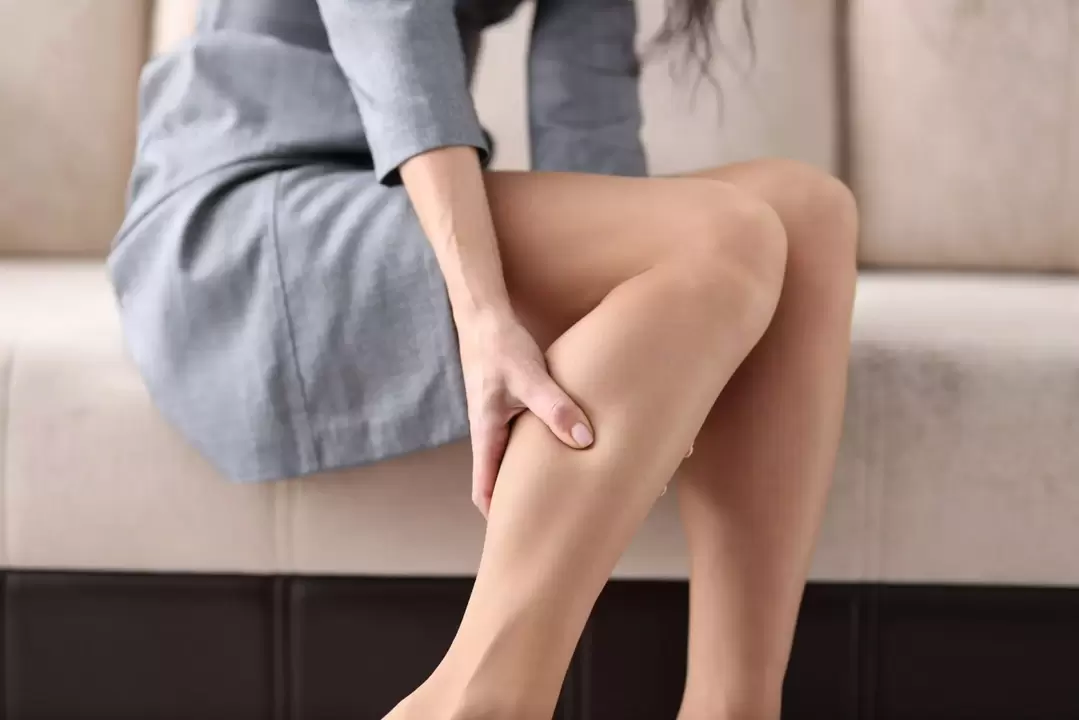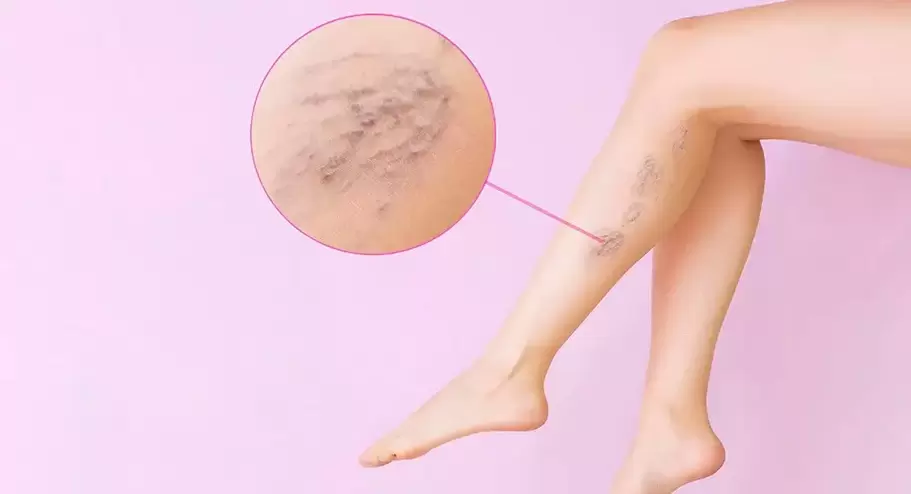Varicose veins is a disease of the veins under the skin, manifested in their dilation and excessive dilatation, the elasticity of the veins is lost, the blood circulation is disturbed. Swollen varicose veins often appear in the legs.
Varicose veins are considered a cosmetic problem, but if left untreated, they can lead to complications. The main causes are trophic ulcers and thrombosis, which develop in 70% of patients with varicose veins.
Varicose veins symptoms
Signs of self-declaration are already in the early stages:
- rapid leg fatigue;
- burning and heaviness in the legs;
- minor swelling appears;
- there is pain in the veins;
- leg cramps.
Another characteristic sign of varicose veins is localized pain in the calf, which appears in the evening and disappears in the morning. The pain is not sharp, the feeling is moderate, pulling.
In the early stages, varicose veins cannot be seen, but varicose veins have developed. Sometimes it takes decades. Gradually, the symptoms became more and more worrisome, the signs of venous insufficiency appeared:
- swelling of the legs - in patients (usually women with varicose veins), chronic venous disease is often accompanied by an increase in the volume of the legs. At the same time, edema as well as pain and heaviness appeared in the afternoon and subsided after sleep. Leg edema is not typical of the disease mentioned, it is a symptom of lymphedema;
- itchy skin;
- knots, bends, visible to the naked eye;
- tan, thickened skin, appearance of bluish tint.
With the progression of venous disease, symptoms intensify. Foot skin deteriorates, eczema and trophic ulcers appear.

Causes of varicose veins
The cause of varicose veins is the weakening of the venous valves in the legs, as a result of which the flow of blood becomes worse. The venous network in the legs consists of superficial and deep veins that are connected by vessels. Superficial veins carry blood away from the skin and subcutaneous structures, while deep veins carry blood away from internal organs. The veins that connect them act as pressure equalizers in shallow and deep vessels.
Proper blood flow goes in the direction from superficial to deep veins. This direction can be provided by the movement of the surrounding muscles and the activity of the vasomotor center, since the bottom-up motion contradicts the force of gravity.
If, for some reason, the flow becomes difficult, the vessel wall becomes inflamed, thinner, the veins dilate, and the cyanotic lymph nodes appear characteristic of varicose veins.
The disease develops as a response to a variety of adverse conditions mentioned below:
- hereditary - weakness of the vascular wall can be passed on from generation to generation and lead to loss of vascular tone;
- working fatigue, standing on their feet - a high-risk group includes those who, due to the nature of their activity, have to sit or stand for a long time;
- frequent pregnancy and childbirth - during this period, the total volume of blood and the compression of the veins increases, causing varicose veins;
- obesity - increased venous pressure in overweight people increases the likelihood of varicose veins;
- failure in the hormonal system - self-administration of contraceptives and other drugs based on hormones causes changes in the venous walls. In women, such a reaction can be observed during pregnancy;
- nutrition - the lack of fresh fruits and vegetables in the menu leads to a lack of fiber, which in turn - weakens the walls of the veins.
What do varicose veins look like?
Because varicose veins are variations of the veins, they are also known as cosmetic problems:
- first, the patient notices the appearance of mesh and vein pattern on the leg;
- later the tendons become zigzag, lifting the skin;
- In the most advanced stages, dilation nodes are clearly visible, indicating dilation and entanglement of blood vessels.
What is the danger of the disease?
What happens if the disease is not treated? It will inevitably lead to complications. The most dangerous is thrombophlebitis and the "separation" of blood clots. 5% of all patients experienced similar complications. With age, trophic ulcers often form, which are difficult to treat. The risk of complications from varicose veins increases over time.
- thrombophlebitis. With it, blood clots form in the leg veins, which can rupture and block the artery, leading to a heart attack.
- Venous thrombosis.Blockage of blood vessels due to blood clots. It is manifested by pain in the legs, which is aggravated by exertion.
- Pulmonary embolism. Obstruction of its lumen by a dissecting thrombus. Death can occur in the first half hour. If the clot is small, a pulmonary infarction may occur.
- Nutritional ulcer.The skin darkens and thins with the further appearance of sores. Occurs due to malnutrition of tissues. Poor response to treatment.
Risk factors
- genetic. If both parents have varicose veins, the chance of the child developing the disease is 90%, if there is a child is 60%.
- Pregnancy.During this stage, venous disease is provoked by 3 factors:
- hormonal changes - the production of progesterone in large quantities relaxes the muscles, making the veins more susceptible to damage;
- pressure of the uterus, which has increased in size - in connection with this, the outflow of blood from the legs worsens;
- increased blood volume by 20-30% - the venous valves in the legs cannot withstand the load, especially if they are weak at first;
- Wrong nutrition.Uncontrolled consumption of processed foods, sugar and salt, fast food, fried and fatty foods, trans fats, preservatives and artificial additives from industrial products also leaves traces.
- Hormonal background.The action of hormones can weaken the veins, causing vasodilation and preventing the valves from closing properly.
- tight clothes. Tight belts, jeans and underwear impede the harmonious circulation of blood, impeding blood circulation.
- High heel. When walking, the veins work to the limit. This is because the load is unevenly distributed - the main part falls on the forefoot. Venous pain, leg swelling are the first signs of varicose veins just starting.

Diagnosis of varicose veins
In the early diagnosis of varicose veins, ultrasound technologies are used - vascular scanning and doppler imaging.
Ultrasound angiography (USAS) is an informative method for noninvasive examination of peripheral blood vessels. It can obtain two-dimensional images of arteries, visualize intravascular structures, and assess the direction and nature of fluid flow.
In severe cases, when a response cannot be obtained with USAS, computed tomography (CT) will be used.
Doppler ultrasound (Doppler Ultrasound) is the easiest method to evaluate peripheral blood vessels. He assessed the condition of the arteries by indirect indicators: the response of the blood flow to functional tests, etc. v.
X-ray contrast phlebography is used in the diagnosis of arterial varicose veins, acute thrombosis and their consequences, as well as varicose veins of the small pelvis.
Varicose veins treatment
surgical technique
It is only possible to completely cure varicose veins after surgical treatment. It is done in three ways:
- phlebectomy - removal of an enlarged dilated vessel;
- Sclerotherapy is the introduction of a special substance into the dilated vein, which "sticks" to the blood vessel wall, normalizing blood flow. swelling of the veins disappears, even a cosmetic defect disappears;
- laser coagulation - the walls of the vein are exposed to heat, so the vein lumen "closes". Manipulation is performed only if the vein is enlarged by no more than 10 mm.
Medical treatment of varicose veins
The leading role in treatment is played by venotonics in the form of tablets. They improve blood circulation, heal the arteries.
Also prescribe venotonic drugs - phlebotonics. They are performed with thinning of the walls of blood vessels, increased permeability, decreased elasticity and fluid stagnation. Preparations strengthen the walls of the veins, increase their elasticity, reduce swelling and other negative signs. An additional quality of phlebotonics is the establishment of microcirculation in the affected area.
Antiplatelet drugs are used to thin the blood in the veins. Medicines are needed when you need to reduce the formation of blood clots. Indicated for patients with increased blood viscosity. You can only take antiplatelet drugs if there is no bleeding tendency.
Anticoagulants are sometimes used to prevent blood clots from forming on an individual basis. They remove blood clots, reduce viscosity. But the decision is made by the attending physician after assessing the potential health benefits and the potential type of rice.
compression therapy
A reliable assistant in the treatment of varicose veins is compression clothing. The working principle of the product is as follows:
- while wearing compression stockings, the pressure on the superficial and deep veins increases;
- the pressure is greatest at the bottom, where the veins are narrowed more and blood flows out fastest;
- due to narrowed veins, the functioning of the valves improves;
- pain, swelling, fatigue in the legs disappear.
A complex approach
There are many treatment options, but the most accurate would be to emphasize the improvement of the whole organism as a whole. Varicose veins in the broadest sense are not only a problem of the veins but also a symptom of a malfunction in the body. So we recommend healing your body, and do it consistently and wisely.
- drink plenty of water - dehydration is one of the causes of blood clotting, especially during hot periods;
- help liver detox - add artichokes, flaxseeds, grapefruit, oranges, apples, cruciferous vegetables, rosemary, dandelion, olives to the diet (make sure that there are no allergic reactions and intolerances to fishmultiplied by the product);
- eliminate from the diet all inflammatory foods that thicken the blood and have an adverse effect on the walls of blood vessels (alcohol, coffee, sugar, cakes, dairy products, smoked foods, junk food, etc. )boxes, fast food, refined food);
- eliminate constipation - they tighten the venous blood flow of the pelvis. Start taking a symbiotic or probiotic. The bacteria in their composition create a balance of the microflora and thus normalize the stool. They improve the condition of the small and large intestines, as well as the gastric mucosa;
- conduct homocysteine analysis - do not exceed 10. If higher, you need to make sure that you are not deficient in vitamin B12, folic acid and iron. At the same time, restore the microflora, otherwise their absorption capacity may be impaired;
- restore protein levels. For verification, a biochemical blood test is given: the optimal protein concentration in adults should be 72-86 g / l, in children - 45 to 80 g / l. ;
- work with insulin resistance - often problems go hand in hand with this disorder. You can tell by the symptoms: constant hunger and frequent cravings, papillomas, red mole-like spots, swelling, thirst and high blood pressure;
- introduce exercises - Pilates, yoga, light cardio;
- improve lymphatic flow - drink water with herbs, cranberries, spices, lemon, ginger;
- contrast bath - under the influence of cold, small vessels begin to narrow, and under the influence of heat, on the contrary, expand. This leads to the strengthening of the walls of blood vessels and increasing their tone.
- restore hormone levels - excessive hormone production dilates blood vessels and prevents valves from closing properly. The symbiosis with broccoli is suitable to assist in the process of restoring hormonal balance. The active ingredient - sulforaphane - that it contains, removes excess estrogen from the body. This is because broccoli contains many cancer-fighting substances such as potassium, zinc, selenium, beta-carotene, amino acids, vitamins A, C and E.

























